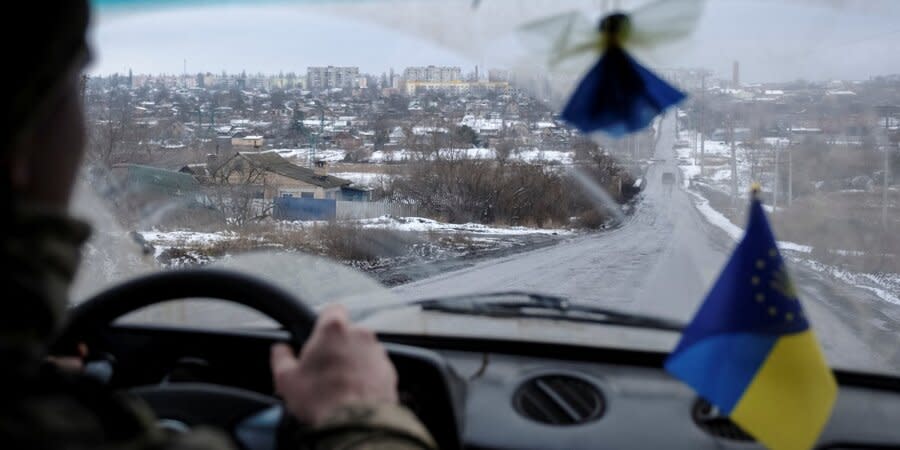Putin may have overestimated Russian military’s own capabilities to capture Donbas by March — ISW

- Oops!Something went wrong.Please try again later.
The ISW “has not observed any evidence that Russian forces have restored sufficient combat power to defeat Ukraine’s forces in eastern Ukraine and capture over 11,300 square kilometers of unoccupied Donetsk Oblast (over 42 percent of Donetsk Oblast’s total area) before March as Putin reportedly ordered,” it wrote.
Read also: Russian troops kill four civilians, injure seven in Donetsk Oblast, governor says
ISW analysts interpreted a statement by Andriy Chernyak, who represents Ukrainian intelligence, that Putin ordered his troops to capture the entire territory of Donetsk and Luhansk oblasts by March 2023 as confirmation of their assessment that a Russian offensive in eastern Ukraine remains the most likely scenario. Chernyak has also stated that Russian forces are redeploying additional unspecified assault groups, units, weapons, and military equipment to unspecified areas of eastern Ukraine, likely in the Luhansk Oblast area, ISW analysts said.
The ISW also considers the blocking of mobile Internet services by the occupying “authorities” in Luhansk Oblast as part of an effort to intensify operational security to conceal new Russian force deployments in Luhansk Oblast.
Read also: Ukrainian military eliminate 800 Russian troops, reports General Staff
In this way, Russia is likely trying to strengthen operational security and avoid the spread of information about the new deployment of Russian troops in Luhansk Oblast. Previously, Ukrainian citizens have used cell phones to collect information about Russian forces in occupied Ukraine and send targeting information to the Ukrainian military.
Previously, ISW analysts predicted that if a major Russian offensive were to begin by April 2023, “it would likely prematurely culminate during the April spring rain season (if not before) before achieving operationally significant effects.” In this case, the culmination of Russia’s forces could “generate favorable conditions for Ukrainian forces to exploit in their own late spring or summer 2023 counteroffensive after incorporating Western tank deliveries.”
The ISW also analyzed a fresh assessment by Oleksiy Reznikov, who stated that the number of mobilized Russian personnel is higher than the Kremlin’s official 300,000 figure. Analysts note that such a figure may be close to the estimate made recently by the Main Directorate of Intelligence (HUR) chief Kyrylo Budanov, who stated that there are currently about 326,000 Russian servicemen fighting in Ukraine, excluding the 150,000 mobilized still on training grounds.
Read also: Close-quarters combat ongoing near Svatove in Luhansk Oblast, says governor
On the other hand, “ISW has not observed indicators that crypto-mobilization efforts in past months have produced as many as 200,000 additional mobilized personnel, however, although it is possible.”
Russian officials are continuing efforts to frame the war in Ukraine as an existential threat to Russian audiences in order to set information conditions for a protracted war and maintain domestic support for continued military operations, ISW analysts note.
“In a Feb. 2 speech at a concert dedicated to the 80th anniversary of the defeat of Nazi troops by the Red Army in the Battle of Stalingrad, Russian President Vladimir Putin claimed that Russia is once again facing a modern manifestation of Nazism that is directly threatening Russian security,” the assessment explains.
However, these efforts are still in vain and do not lead to the desired motivational effect of Russians to participate in the war. ISW analysts have cited figures indicating that Russian state services have faced increased demand for foreign passports and have suspended applications for new passports since Feb. 2, in particular due to a shortage of microchips for such documents. The Ministry of Internal Affairs of Russia reported that more than 5.4 million foreign passports were issued in 2022, which is 40% more than in the previous year. “The Kremlin need not look further than passport statistics to poll domestic attitudes on the Russian population’s desire to fight Putin’s war,” writes the ISW.
Key takeaways:
● Russian and Ukrainian sources suggested that Russian forces may be preparing offensive actions in the Svatove area;
● Russian forces intensified ground attacks in the Kreminna area on Feb. 2;
● Russian forces continued ground attacks northeast and southwest of Bakhmut;
● Russian officials are likely trying to prepare the Russian military’s disciplinary apparatus for an influx of mobilized personnel;
● Russian forces and occupation authorities continue efforts to identify and arrest Crimean Tatars on allegations that they associate with extremist movements outlawed in Russia.
Read the original article on The New Voice of Ukraine

